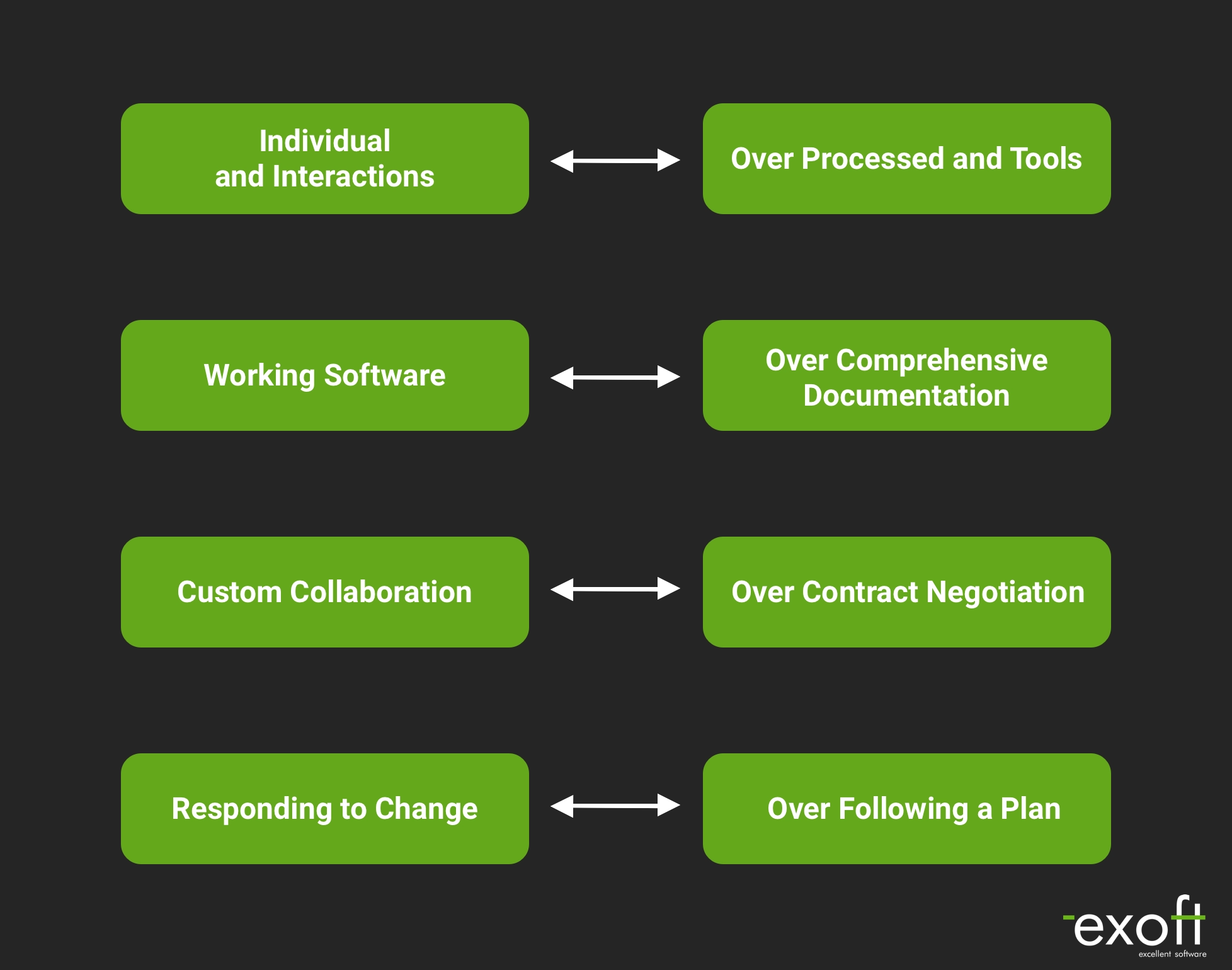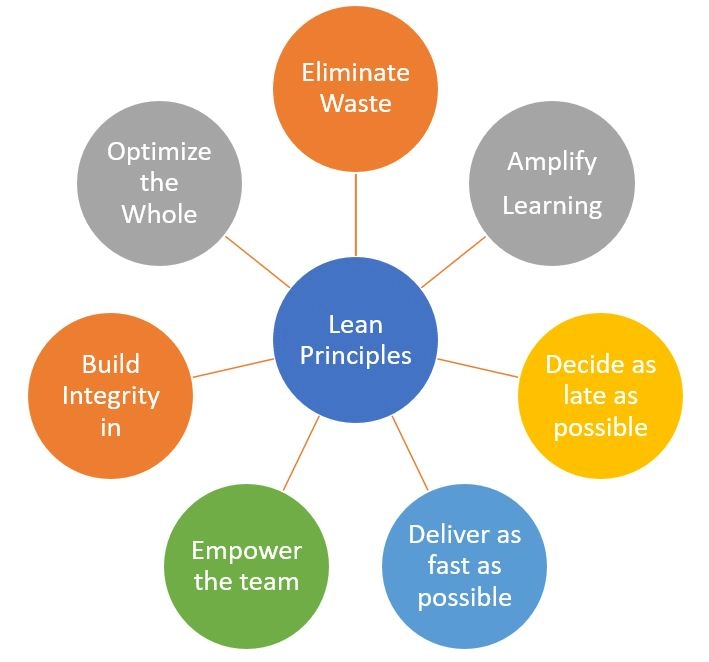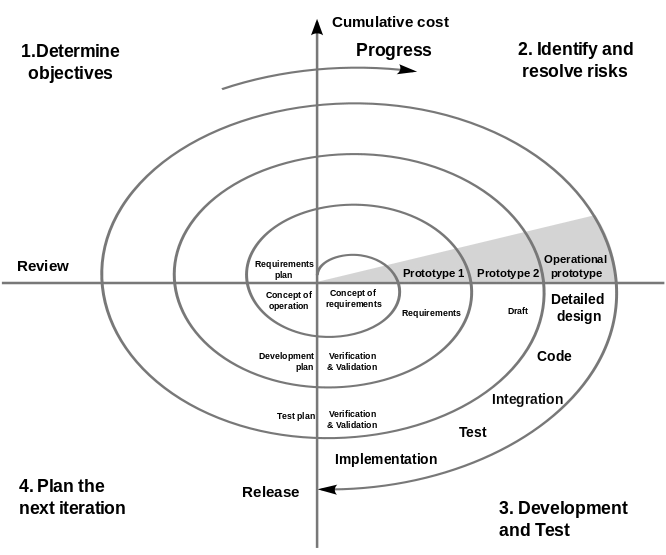Case study
Are you torn between Agile’s iterative flexibility, Scrum’s team-focused sprints, and Waterfall’s structured predictability? Make the right decision by looking at your project specifications and software development goals. Our post compares and contrasts the three methodologies and explores how each handles changes, risks, and timelines.
When embarking on a software development project, choosing the right methodology is crucial. In this article, we present a comprehensive software development methodologies comparison, exploring the pros and cons of various approaches such as Agile, Scrum, Waterfall, and more. Our case study on a software solution for agriculture showcases how the right methodology can drive innovation and efficiency in industry-specific applications. By understanding software development trends and methodologies, you can make an informed decision that aligns with your project's needs and goals. Exoft, with its extensive experience in software development, offers insights and recommendations to help you navigate these choices effectively. Dive in to discover the best methodology for your next project.
Agile Methodology Pros and Cons
An agile development methodology is an innovative approach to project management that advocates flexibility and continual improvement. Its main principles are outlined in the famous Manifesto for Agile Software Development , written and published in 2001 by 17 prominent software engineers.

Unlike many other software development methods described in this article, agile software development methodology doesn’t provide specific rules of how the work should be done. It is rather an umbrella term that covers a set of development models which are based on the same values. They, for instance, include Scrum, Kanban, and Extreme Programming.
Pros:
- puts a focus on users and the product’s business value while
- encouraging active stakeholder engagement
- allows a development team to detect and fix issues early on and timely
- respond to changing market conditions
- comprises iterative development methodologies that provide a high
- level of predictability in terms of costs and schedule
- minimizes risks and reduces time to market
Cons:
- due to constant improvements and amendments, product creators can
- easily get off the track and go too far from the original product idea
- may cause a lack of necessary documentation
SCRUM Methodology Advantages and Disadvantages
Scrum development model is an iterative methodology that is widely applied in software projects. Its basic rules include dividing the development process into short splints and delivering a product incrementally. Since the Scrum development methodology belongs to the agile project management approaches, it offers all the benefits and drawbacks mentioned above. Additionally, the pros and cons of Scrum methodology must be considered.

Pros:
- result-oriented; increments are released every 2-4 weeks
- suits for building and maintaining complex products of high quality
- creates perfect conditions for high team’s productivity
- ensures effective use of a budget
- facilitates better collaboration within a team and between a team and a client
Cons:
- decision-making falls mainly on the team’s shoulders, so only cooperative and motivated professionals should be involved in a project
- it may be a challenge to adopt the Scrum framework in a short period and in large teams
Feature-driven Development Pros and Cons
Like Scrum, a feature-driven development (FDD) model is based on an iterative and incremental product development process. The main difference between these types of software development methodologies is that FDD is built around features and determines five stages of a project lifecycle:

After going through all the stages and receiving user feedback, a team begins the next iteration. Showcasing increments to customers is a key component of the FDD software development methodology since it guides programmers in the right direction no matter how complex a project is. Understanding the feature driven development advantages and disadvantages is essential for evaluating its suitability for your project.
`Pros:
- offers a straightforward and easy-to-implement product development process
- scalable; perfectly fits long-term projects with large teams involved
- facilitates rapid development since a team moves quickly through a set of predefined steps
- A transparent process that makes progress and results clearly visible
Cons:
- not the best choice for small and short-term projects
- requires leading programmers to supervise the process
- timeline and costs may be difficult to estimate
LEAN Methodology Advantages and Disadvantages
The lean development methodology is a project management concept that came to software development from manufacturing. Like Agile, it provides just basic principles, not strict rules. So teams can use different tools such as Kanban boards, value stream mapping, and Kaizen to implement this approach into projects.

The core idea of the lean development methodology is centered around waste reduction. It means that teams should remove all unnecessary things from the product creation process and strive to use minimum resources to bring value.
Pros:
- good fit for low-budget projects
- has a rapid development cycle that results in reduced time to market
- allows for project scalability and cross-team cooperation
Cons:
- requires precise documentation
- a team can easily lose focus since there are no rigid rules and deadlines
Extreme Programming Pros and Cons
XP is another agile product development methodology. It comprises a set of specific practices that aim to achieve the advanced quality of software solutions and improve their responsiveness to ever-changing market conditions. But the framework doesn’t offer something that is completely new to the project management world. It just takes proven methodologies in software engineering and takes them to an extreme level. That’s where the XP model gets its name from. The development process in extreme programming is irritative, like in Scrum and Lean methodologies. Evaluating the advantages and disadvantages of extreme programming can help determine its effectiveness for your software development process.
Pros:
- effective for building software in high-risk environments and when requirements are uncertain
- ensures that customers’ needs are met even if they change over time
- short iterations allow a team to release frequently and test code thoroughly
- absence of unnecessary processes and documentation often leads to significant cost-saving
Cons:
- shows the best results only when end-users are extensively involved in a project
- heavy reliance on communication makes projects vulnerable to situations when team members are replaced
Pros and Cons of Waterfall Methodology
The waterfall model is an absolute opposite of iterative development methodologies. It offers a linear approach to the product creation process, meaning that a new phase starts only after the previous one is completed. Unlike agile frameworks, waterfall development methodology doesn’t provide guidelines on receiving customer feedback and going back to implement the changes. That’s why it’s often regarded as the most traditional among top software development methodologies.

Pros:
- easy to understand and implement even if a team has never worked with it before
- makes a budget, a timeline, and results predictable for a client
- allows for a transparent and straightforward testing process since all
- functional requirements are described in detail in software documentation
- a good fit for simple short-term projects
Cons:
- lack of flexibility; adjusting a product to the changed conditions may be a problem
- only suits for projects that have precise requirements
- cannot be used for building products that are to be released on highly dynamic markets
- longer delivery time as compared to iterative development models
Pros and Cons of Prototyping Methodology
The prototyping development model takes a lot from both agile and waterfall methods. Most of its stages are executed sequentially, just like in waterfall development. But before programmers create a real product, they build a prototype, get customer feedback, and rework it as many times as needed to receive an acceptable result. So, basically, the prototyping software development methodology follows a well-known trial and error approach, except it does experiments with a prototype, not a full-fledged solution.

Pros:
- allows product creators to test the assumptions and minimize the risk of failure
- gives clients a clear idea of what their product will look like and how it will function at the early stage of a project
- helps to gather and finalize product requirements
Cons:
- high management costs; unpredictable budget and timeline
- prototype testing and refining may require several iterations, extending time to market
- too many modifications can destroy the original idea and disturb the workflow
Rapid Application Development (RAD) Model Pros and Cons
The main goal of a rapid development methodology is to get a product prototype to customers as quickly as possible. It’s very similar to the prototyping model, except that the rapid methodology puts a greater focus on the development speed and the entire work is centered around fast iterations. Besides, the rapid model is very user-oriented. A team frequently gathers customer feedback and adapts a product if needed.

Pros:
- allows clients to build a product quickly with a small team involved
- adjustments can be easily made as many times as necessary
- ensures high customer satisfaction
- a team doesn’t waste time on upfront planning
Cons:
- difficult to implement in large teams
- requires significant user involvement
- results heavily depend on the team’s capacity and performance
Dynamic systems development model
The dynamic systems development methodology is an agile framework that puts the product’s impact on business at the forefront of a project. But unlike different software development methodologies that we mentioned before, this framework is more formalized. It requires close attention to detail as well as staying within a strict budget and timeframe. User feedback and functionality remain of high importance. However, quality and schedule are the top priorities.

Pros:
- combines flexibility and on-time delivery
- ensures that developed products have real business value and aline with the overall strategy
- perfect fit for enterprise software development projects
- simplifies communication between programmers and end-users
Cons:
- often requires a dramatic change in an established company’s culture
- costly implementation
- may restrict innovation and programmer creativity
Spiral Methodology Advantages and Disadvantages
The spiral development methodology combines elements from other project management models, i.e., agile, waterfall, prototyping, and puts a big emphasis on risk handling. It’s based on incremental releases, allowing a development team to constantly refine a product. In this framework, the iterations are called ‘spirals’. Each spiral contains four phases: identification, design, construct, and evaluation. Going through phases within one spiral follows a linear manner, like in the waterfall development model. Understanding the spiral model pros and cons is crucial for determining its applicability to iterative software development projects.

Pros:
- perfectly suits for projects in which risk evaluation is crucial
- helps to effectively handle complex and uncertain requirements
- allows product creators to gather a lot of customer feedback
- facilitates fast development process since a team follows a predefined procedure
Cons:
- requires a lot of management effort
- creates room for going beyond the set timeline and budget
- too expensive for small companies and isn’t the best fit for small projects
Joint Application Development methodology (JAD)
The joint application development methodology is a framework for building software products that implies conducting a set of workshop sessions. Participants include not only programmers and potential customers but also, a facilitator, observers, experts, and mediators. All decisions are made through group consensus. The JAD model also strives to eliminate errors as early as possible to avoid high expenses later on.

Pros:
- helps to look at a product concept and development process from different angles
- ensures that all stakeholders are on the same page and have a single vision of a product
- differences can be resolved in short time
- immediate elimination of bugs and issues results in high-quality and maintainable solutions
Cons:
- organizing workshops sessions with many participants may be a challenge
- constant discussions can make it difficult for a development team to maintain a focus
Rational Unified Process (RUP) methodology
The idea behind the RUP development methodology is to provide businesses with a structured way to build software solutions, including specialized applications like construction ERP systems. It originates from a subdivision of IBM and offers a specific plan for a development process. According to the rational unified process methodology, the latter should consist of four phases: inception, elaboration, construction, and transition. Each phase is divided into six core development workflows: business modeling, requirements, analysis & design, implementation, test, and deployment.

Pros:
- helps to deal with and adapt to uncertain requirements
- defines clear rules that a team should follow
- prevents wasting of costs and other resources
- requires creating reliable documentation
Cons:
- heavily relies on the team’s expertise
- rather complicated; hard to implement straight away
Conclusion
When it comes to choosing the best software development methodology, there is no one-fits-it-all solution. Every methodology has its advantages and drawbacks, so everything depends on your requirements and the type of a project. But one thing that is common for all approaches is that they can bring real benefits only if implemented by a team of professionals. That’s why finding a reliable technical partner is even more important than deciding what framework to apply.
